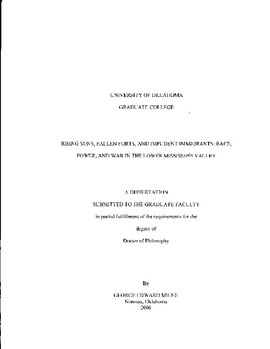| dc.contributor.advisor | Piker, Joshua A., | en_US |
| dc.contributor.author | Milne, George Edward. | en_US |
| dc.date.accessioned | 2013-08-16T12:20:25Z | |
| dc.date.available | 2013-08-16T12:20:25Z | |
| dc.date.issued | 2006 | en_US |
| dc.identifier.uri | https://hdl.handle.net/11244/1109 | |
| dc.description.abstract | Their assumption became untenable when hundreds of Europeans and their African slaves moved into Natchez country. The resultant web of Indian, French, and African communities created a unique matrix for the production of a new racial category: red men. The plantation system of the 1720s gave the Natchez and neighboring groups opportunities to see the Europeans dominate Africans, a permanent underclass identifiable by skin color. The colonists also attempted to marginalize the Indians as "racial inferiors". In response, Natchez leaders appealed to a shared identity as red men to quell their internecine rivalries and forge an anti-French coalition among their villages. | en_US |
| dc.description.abstract | During the 1720s, colonial observers recorded Southeastern Indians using the term "red men" to distinguish themselves from the "whites" and "blacks" from overseas. The Natchez embraced this red identity, using it to unite factions within their nation and then employed the solidarity that it created to eject the French from their homeland. This dissertation reconstructs the ways that Native Americans in the Lower Mississippi Valley co-opted the European discourse of racial categories and shaped it to achieve their own ends. | en_US |
| dc.description.abstract | In 1729, the Natchez struck, destroying the newcomers' farms and forts. The Indians' success was transitory; the French counterattacked, killing or enslaving hundreds. Because of persistent attempts to exterminate the remaining Natchez, France alienated many of the Southeast's Indian nations. Weakened diplomatically, the French could no longer resist their British adversaries and lost their colonies in North America. The legacy of redness, however, survives to this day. | en_US |
| dc.description.abstract | This chain of events began when Indians and Europeans assumed that the other would fit handily into their respective social orders. To the French, the Natchez's temples and hereditary leadership resembled the ancient civilizations of the Old World, ripe for conversion. To the Natchez, the first Frenchmen who arrived in the 1680s often looked and acted like Native Americans. The handful of Europeans who followed frequently joined Natchez kinship networks and rendered service to native political leaders. The Europeans' willingness to adapt culturally lulled the Natchez into believing that the French were candidates for assimilation. | en_US |
| dc.format.extent | xi, 269 leaves : | en_US |
| dc.subject | Natchez Indians Wars, 1729. | en_US |
| dc.subject | History, United States. | en_US |
| dc.subject | France Colonies. | en_US |
| dc.subject | Mississippi River Valley History 18th century. | en_US |
| dc.subject | Natchez Indians History. | en_US |
| dc.subject | Indians of North America Mississippi River Valley History. | en_US |
| dc.subject | Native American Studies. | en_US |
| dc.title | Rising suns, fallen forts, and impudent immigrants: Race, power, and war in the Lower Mississippi Valley. | en_US |
| dc.type | Thesis | en_US |
| dc.thesis.degree | Ph.D. | en_US |
| dc.thesis.degreeDiscipline | Department of History | en_US |
| dc.note | Source: Dissertation Abstracts International, Volume: 67-10, Section: A, page: 3950. | en_US |
| dc.note | Adviser: Joshua A. Piker. | en_US |
| ou.identifier | (UMI)AAI3238358 | en_US |
| ou.group | College of Arts and Sciences::Department of History | |
